This post may contain affiliate links. I only recommend products or services that I personally use or trust, promise!
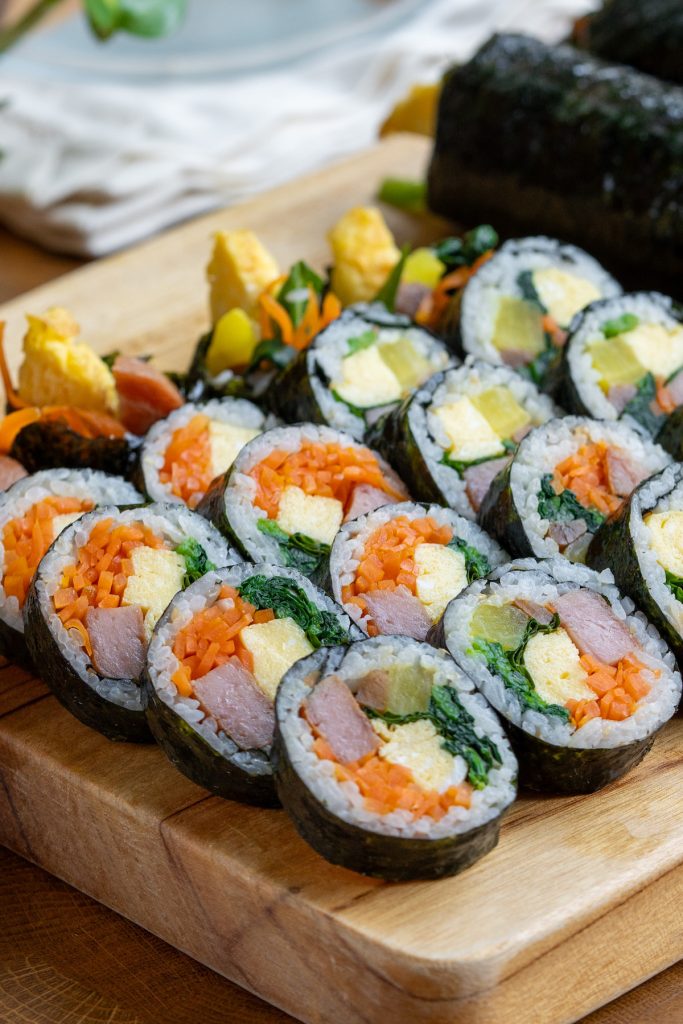
Gimbap is the ultimate Korean picnic/street food, and can be made in a variety of ways. This recipe is a very authentic, classic gimbap. Whenever I think of gimbap, this is how I expect it to taste!
I’m not really sure why, but gimbap is another one of those dishes that I am very picky about. I’ve had gimbap from so many different restaurants, grocery stores, and street vendors, and somehow a lot of them manage to screw it up.
These days, a lot of the popular gimbap rolls have bulgogi in them, or even cheese. The classic gimbap that I grew up with was made with fish cakes or crab sticks.
What is Gimbap?
In Korean, “gim” means seaweed and “bap” means rice. It is a seaweed roll with prepared veggies and some type of protein in the middle. Some people call it the Korean version of sushi rolls, but history shows that gimbap was already a Korean staple before the Japanese invasion.
Gimbap is a very common food for picnics, school lunches, or street vendors. The most common type of food cart you will see in Korea usually has tteokbokki (spicy rice cakes), mandu (dumplings), odeng (fish cakes) and gimbap all together. It is not uncommon for people to stop by one of these carts and order one of everything. I dip my gimbap and mandu into the tteokbokki sauce and wash everything down with a hot cup of the odeng broth. It’s sooooo good!
One great thing about gimbap is that is can be completely customized to your liking. Although I love a classic gimbap, some of my other favorite versions are ones with perilla leaves or kimchi inside. I also really love tuna gimbap!
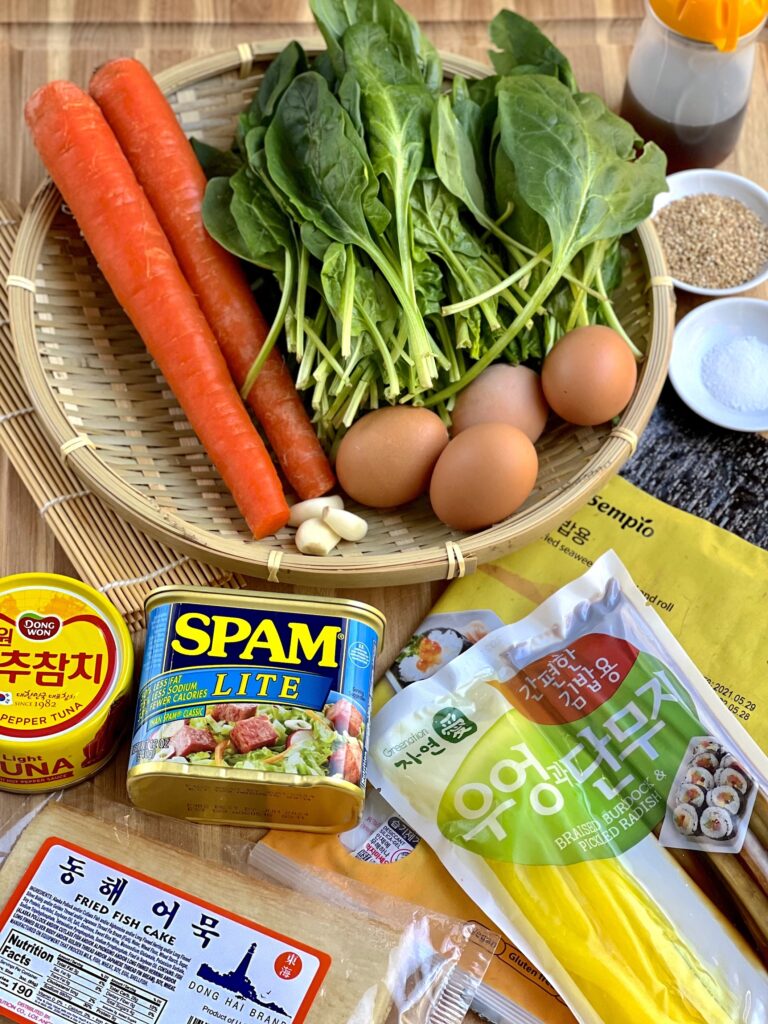
Ingredients
- Fresh rice- always use freshly made short grain rice for gimbap. Just make sure the rice is not still hot when you start to build the rolls.
- CRUSHED sesame seeds- toasted sesame seeds are traditionally added to the rice in gimbap. I like to grind them up a bit before adding to the rice- it releases more of the delicious nutty flavor that sesame seeds have and I think it really elevates the rice.
- Nori sheets- unseasoned & roasted seaweed sheets can be found at any supermarket these days. If you can’t find a Korean brand, anything labeled as “nori” will also work.
- Sea salt- you can use kosher salt if you don’t have sea salt, but I highly recommend getting some sea salt. It does make a difference especially in gimbap.
- Sesame oil- this is an essential ingredient for gimbap- do not leave it out! Sesame oil is so important for seasoning gimbap and will give it the classic taste that it is known for. It will be used to season the rice, spinach, and brushing onto the rolls before cutting.
- Spam- for this gimbap recipe, I am using spam as the source of protein. You can use fish cakes, canned tuna, crab sticks, bulgogi, or anything else you want.
- Veggies- I’m using all the traditional veggies for gimbap- spinach, carrots, yellow pickled radish, and seasoned burdock root. Of all these, I think the most important ingredient is yellow pickled radish. Gimbap simply would not taste like gimbap without it.
- Eggs- a classic gimbap roll will always have eggs!
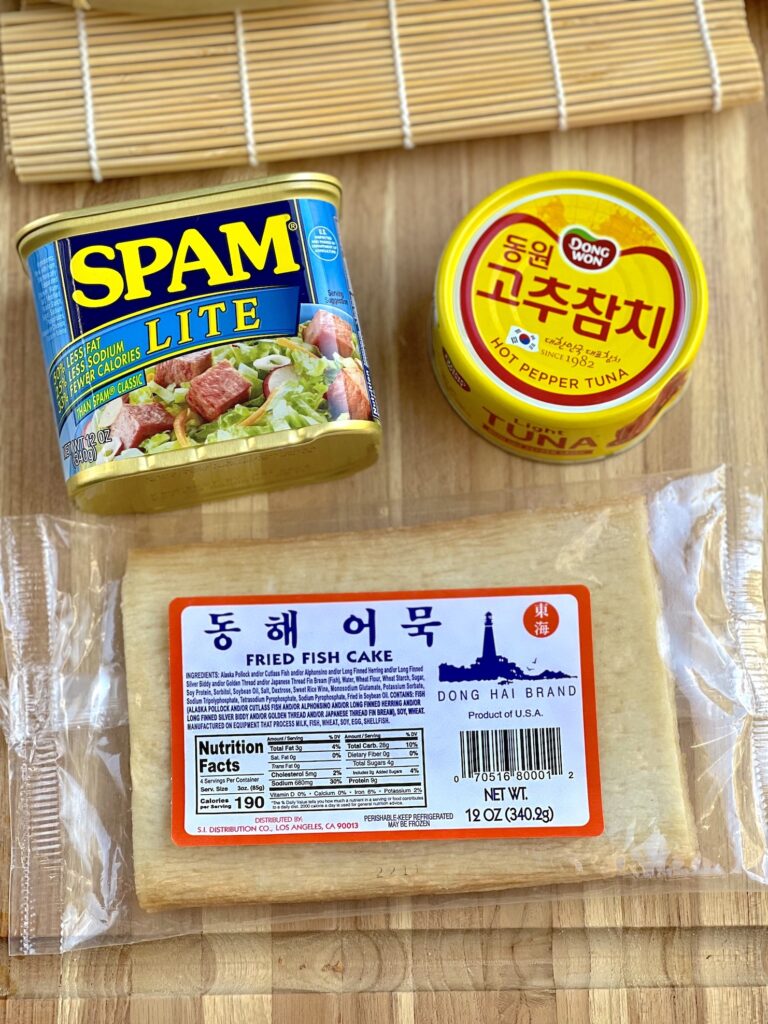
Protein options
If you want to use this recipe but don’t like fish cakes or want to try something different, there are plenty of other options you can choose from. Gimbap has endless possibilities and can be customized in any way you like! Here are some of the most common options:
- Fish cake- this is the most classic version of gimbap, though probably not the most popular anymore. You can use ANY kind of fish cakes in any shape. Just cut them into an appropriate size/shape to fill the rolls. See the photo above for the brand I use.
- Spam- my mom made gimbap using spam a lot when I was a kid. It’s easy, cheap, and has a ton of flavor.
- Bulgogi- probably one of the more popular choices today. It’s good, but probably my least favorite.
- Canned tuna- I really love tuna gimbap. Especially with the addition of mayo and celery. Korean canned tuna is also available in different flavors. I love the hot pepper flavor tuna in gimbap!
- Crab sticks- this is another protein for the classic version of gimbap. I prefer fish cakes but this is still good too. And super easy since you don’t need to cook it.
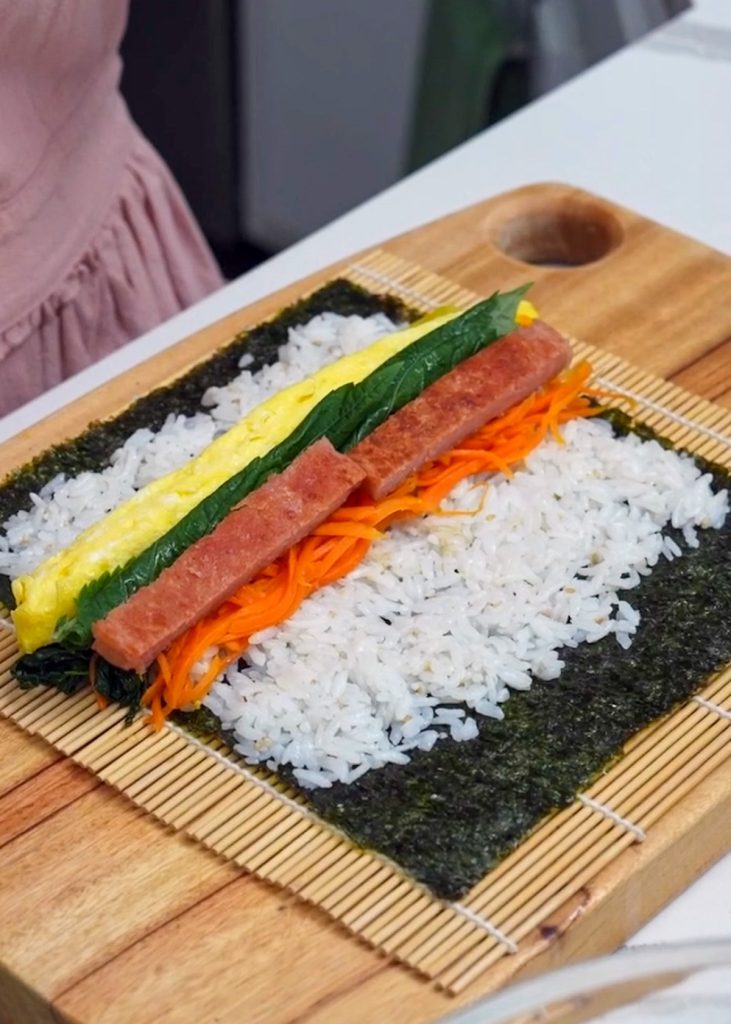
Where to purchase tools/ingredients
To make gimbap, you will need a bamboo rolling mat. You should be able to find this at any Asian supermarket, Daiso, and some American markets. If you’re having trouble finding one or don’t want to bother looking, you can buy one from Amazon here for only $4.
Of all the ingredients, I think the most difficult ones to find for some will be the fish cakes, pickled yellow radish, and seasoned burdock root. Unfortunately these are all perishable ingredients and not easily found online, but I’ve provided photos for your reference. You should be able to find these ingredients at any Korean supermarket.
The pickled yellow radish and seasoned burdock root are usually sold together specifically for making gimbap. I buy this one pictured below.
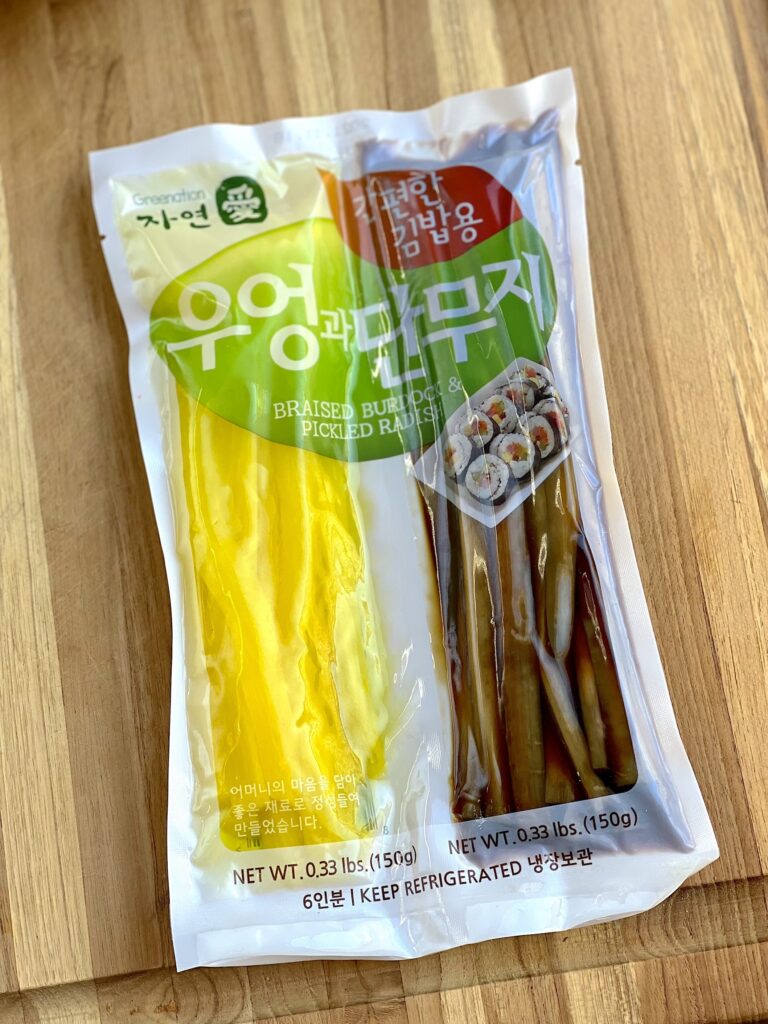
Shelf life/reheating
I have already received a ton of questions about storing gimbap and/or reheating it. I’m going to be very honest about this- just finish it the same day you make it. Gimbap does not store well for a long time, and it doesn’t taste good reheated in my opinion.
If you aren’t going to be eating the gimbap right away, store it in an airtight container or wrap in plastic or aluminum foil and do not cut it until you’re ready to serve. This helps to keep the rice from drying out. Do not store in the refrigerator, or the rice will get hard.
If you don’t finish it in the same day and must refrigerate it, you’re only option now is to reheat the gimbap (which I don’t recommend).
To reheat, you have a couple options:
Reheat on a pan with a little oil until the rice on both sides gets a little crispy.
Whisk some eggs and dip the gimbap in it, then fry in a little oil. This is basically gimbap jeon.
These are decent options when you have too much gimbap and don’t want to waste it. But I don’t ever recommend reheating gimbap since it doesn’t taste the same.
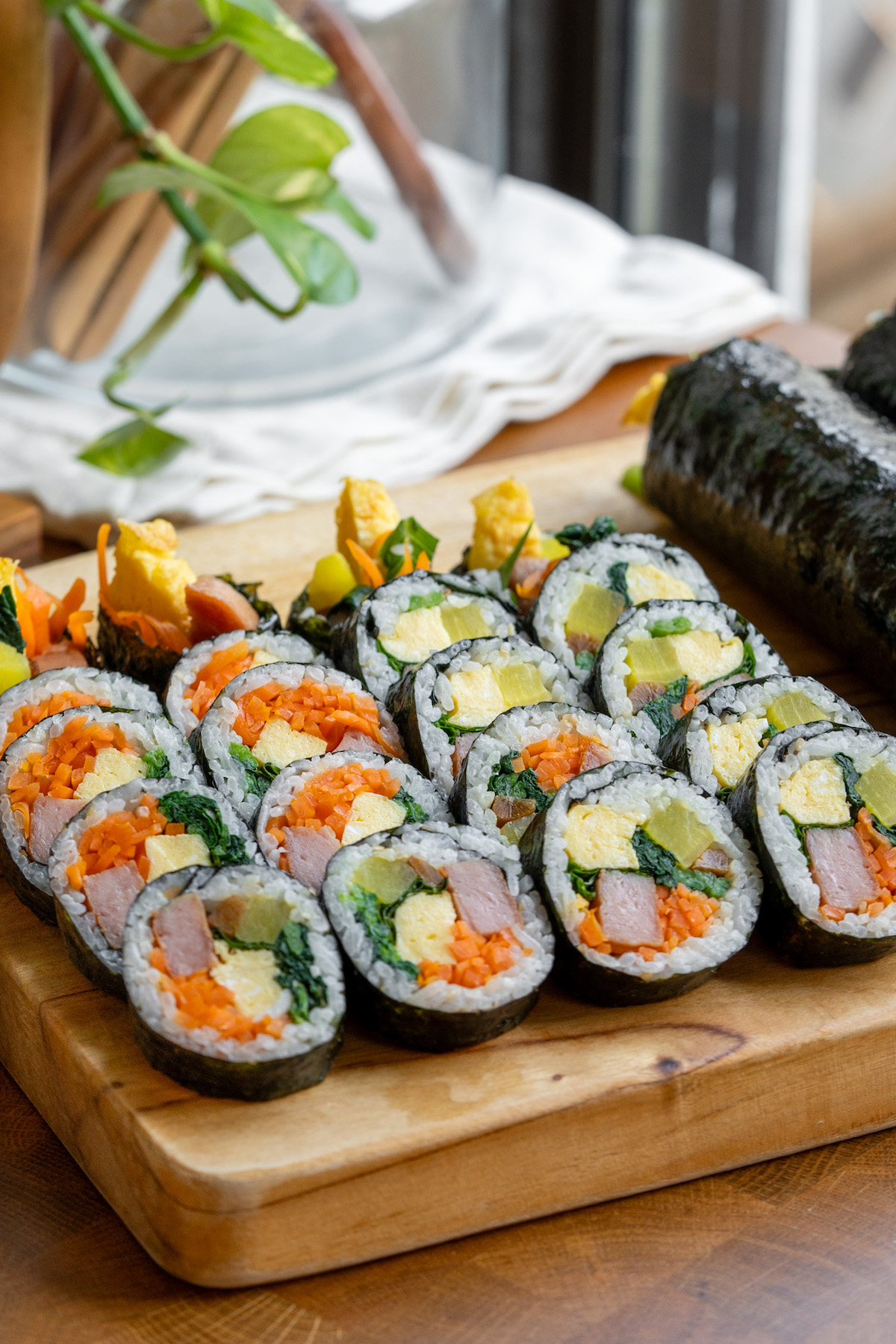
More Korean street food recipes
If you’re making gimbap, make it a full Korean street cart experience by adding some of these recipes to your spread!
Gimbap is commonly sold together with mandu (dumplings), tteokbokki (spicy rice cakes), and/or odeng (fish cake soup).
I usually dip my gimbap and mandu into the tteokbokki sauce and wash everything down with a hot cup of the odeng broth!
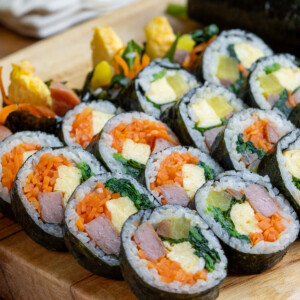
Gimbap (Korean Seaweed Rolls)
Ingredients
- 4-5 sheets of seaweed
- 4-5 strips yellow pickled radish
- 4-5 strips burdock root
- 1/2 can spam, or fish cakes, tuna, bulgogi
- vegetable oil, for pan frying
- sesame oil, for brushing over rolls
- 8-10 perilla leaves, optional
Rice
- 4 cups fresh cooked rice, short grain
- 1 tsp sea salt, or kosher salt
- 1 tbsp sesame oil
- 1 tbsp crushed sesame seeds
Spinach
- 10 oz spinach
- 1/4 tsp sea salt
- 2 tsp sesame oil
- 1 minced garlic clove
Carrots
- 8 oz carrot, julienned thinly
- 1/4 tsp kosher salt
Egg
- 3 eggs
- pinch of salt
- pinch of sugar
Instructions
Prepare the rice
- Make a fresh pot of rice. Mix the rice with crushed sesame seeds, sea salt and sesame oil then set aside.*Always use fresh rice, but let it cool before making the rolls. Do not spread hot rice on seaweed.
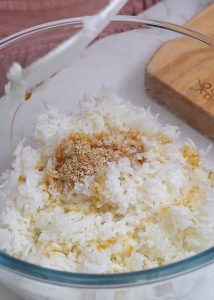
Prepare the spinach
- Thoroughly wash the spinach and blanch them in boiling water for 20 seconds, then immediately drop the spinach into an ice bath to prevent it from cooking more. Then gently squeeze out as much water as you can.
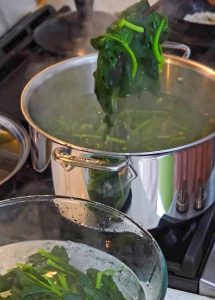
- Mix the spinach with sea salt, sesame oil, and minced garlic. Set aside.
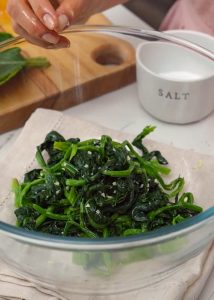
Prepare the carrot
- Thinly julienne the carrots and add salt to draw out water. Let it sit for 10 minutes.
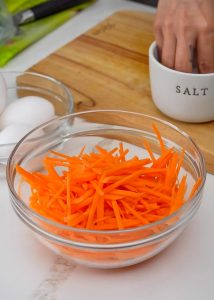
- After 10 minutes, discard the water and gently squeeze out the moisture from the carrots.
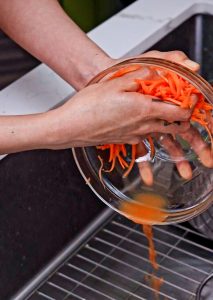
- Pan fry with a little vegetable oil for 2-3 minutes. Set aside.

Prepare the egg
- Whisk together 3 eggs, a pinch of salt, and a pinch of sugar. Pour about 1/3 of it into a hot pan with oil on medium-low heat. Spread the egg evenly.
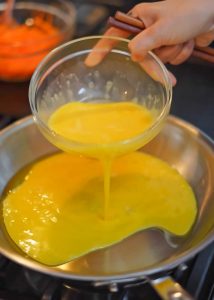
- When the top is almost set, begin folding the egg over, gently pulling it to the opposite side of the pan as you fold it over. Keep adding the egg in batches and repeat until all the egg has been used and folded over.
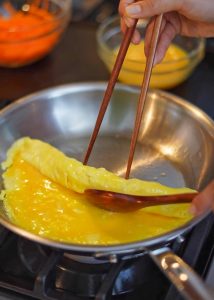
- Cut the egg omelet into 1 cm thick strips and set aside.
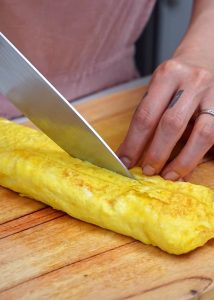
Prepare the protein
- Cut the spam into 1 cm thick slices. Pan fry the spam on both sides until crispy. *If using fish cake, pan fry in a little oil for a couple minutes.
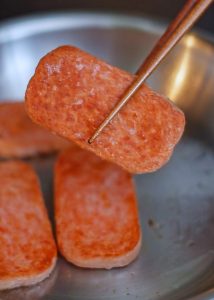
- Cut the spam into 1 cm thick strips. Set aside
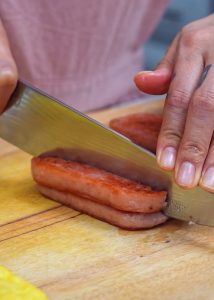
Make the gimbap roll
- On a bamboo rolling mat, set the seaweed sheet shiny side down and evenly spread about 3/4 cups of rice, leaving 2 inches at the top. *If you find that the rice is too difficult to spread, set aside a little cup of water to dunk your fingers in to make the rice spread easier.
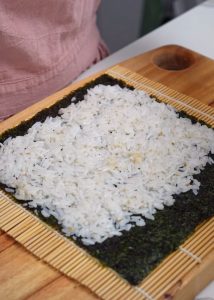
- Neatly arrange all the fillings in the center. I really like yellow pickled radish so sometimes I add two. I also added some perilla leaves. *You can add whatever fillings you like! Sometimes I use fish cakes, canned tuna, or bulgogi.
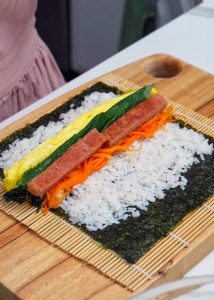
- Lift the bamboo mat from the bottom and begin rolling, tucking in the fillings as tightly as possible. Then using the bamboo mat, apply pressure while rolling and pulling the top of the bamboo mat forward to continue rolling.
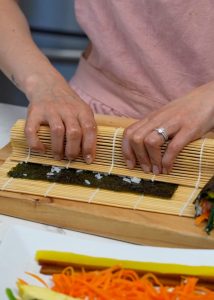
- Drizzle over a little sesame oil and brush all over the rolls.
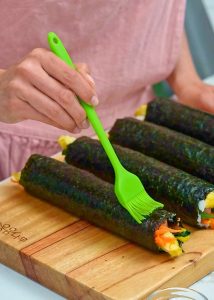
- Cut into 1/2 inch thick pieces using the sharpest knife you own.
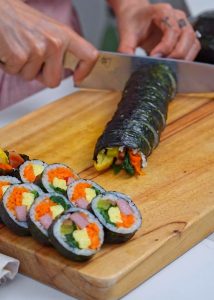
- Enjoy right away or cover in plastic wrap for later. I recommend eating within 1 day. Do not refrigerate unless reheating later (see notes below).
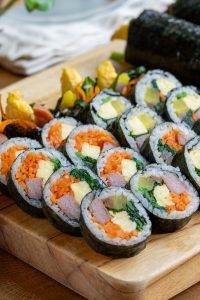
Notes
Nutrition information is automatically calculated, so should only be used as an approximation.


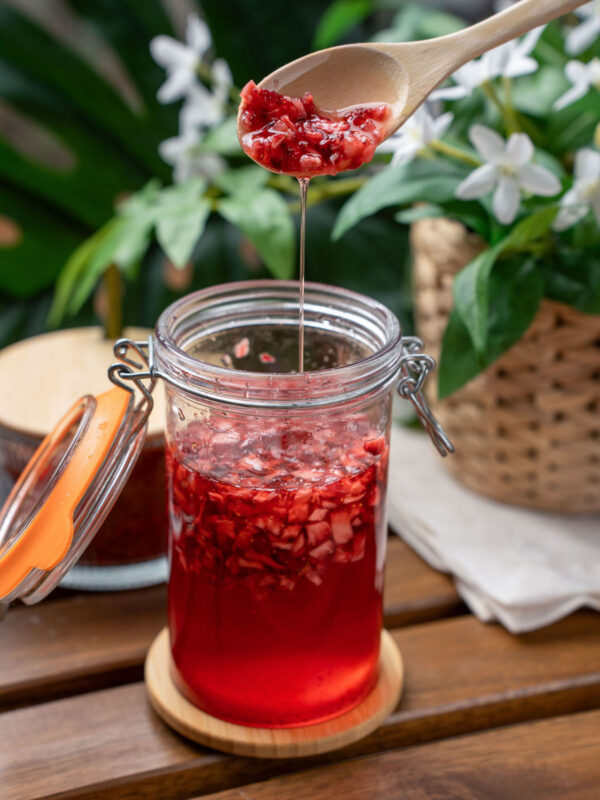
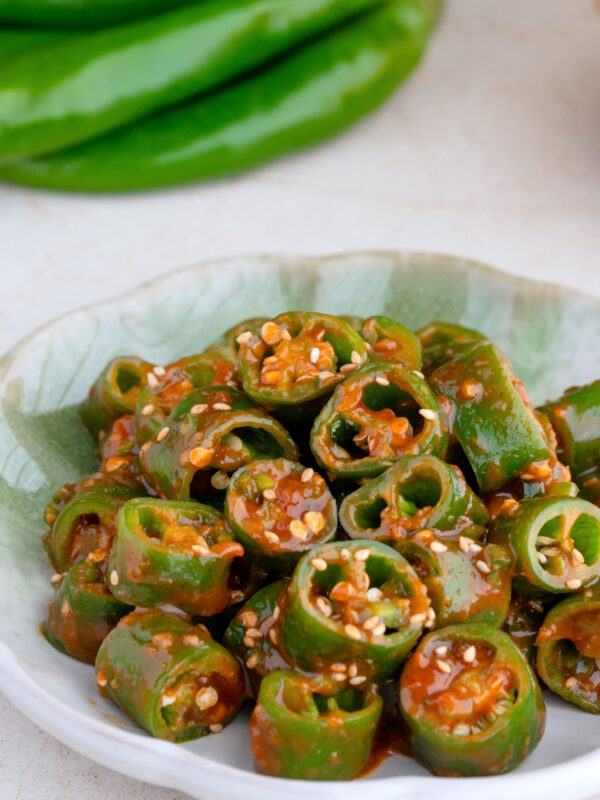







Great recipe as always! I started loving korean food by Squid game and Tastefully yours, and this recipe is definetly worth a try for everyone!
I love kimbap and your recipe is a go to for me when I crave korean food. It’s such an easy recipe for a lunch and even for picnics.😍
Such a good classic, and I love how customizable it is depending on what you already have in your kitchen. I’ve done this with the spinach, carrot, and egg, plus some leftover al pastor pork!
Thank you for sharing!
Love making this! Very good recipe!
I use my air fryer to reheat them with at low temperature. Better than ever ?
I like the end pieces ?
Me too! I usually eat those first to sample and make sure it’s good 🙂